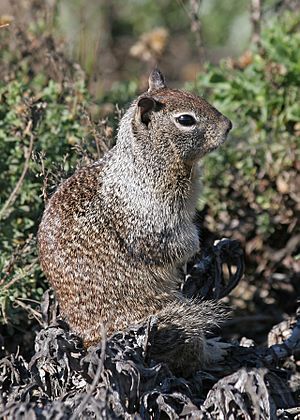California ground squirrel facts for kids
Quick facts for kids California ground squirrel |
|
|---|---|
 |
|
| Conservation status | |
| Scientific classification | |
| Genus: |
Otospermophilus
|
| Species: |
beecheyi
|
| Synonyms | |
|
Arctomys (Spermophilus) beecheyi Richardson, 1829 |
|
The California ground squirrel (Otospermophilus beecheyi) is a common animal. You can easily spot it in the western United States and the Baja California Peninsula. It lives in Oregon, California, Washington, and northwestern Nevada. These squirrels were once called Spermophilus beecheyi. But scientists later found they belong to a different group called Otospermophilus.
| Top - 0-9 A B C D E F G H I J K L M N O P Q R S T U V W X Y Z |
What's in a Name?
The California ground squirrel was first described by John Richardson. He named it after Frederick William Beechey. Beechey was a British explorer and naval officer from the 1800s.
About the California Ground Squirrel

These squirrels have mottled fur. This means their fur has a mix of gray, light brown, and dark hairs. Their shoulders, neck, and sides are a lighter gray. The fur around their eyes is whitish. Their belly is lighter, often buff or yellowish-gray.
They are about 30 cm (12 in) long from head to body. Their tail adds another 15 cm (6 in). They can weigh from 280 to 738 grams (about 0.6 to 1.6 pounds). Their tail is quite bushy for a ground squirrel. This can sometimes make them look like a fox squirrel at first glance.
Where They Live
California ground squirrels live in burrows. They dig these burrows themselves. Sometimes, several squirrels share a burrow system. But each squirrel usually has its own entrance.
They can get used to humans. They might even take food from picnickers. However, they usually stay close to their burrow. They rarely go more than 50 meters (164 ft) away.
When They Are Active
In colder places, these squirrels hibernate for several months. This means they go into a deep sleep during winter. But in areas with mild winters, they stay active all year. If summers are very hot, they might also estivate. This is like a short summer nap to escape the heat.
California ground squirrels can sometimes be seen as a pest. This is because they eat plants and trees in gardens and parks. They mostly eat seeds, like oats. But they also enjoy insects such as crickets and grasshoppers. They also eat various fruits.
Life Cycle of the Squirrel
California ground squirrels mate in early spring. This mating season lasts only a few weeks. A female squirrel usually has one litter each year. A litter can have five to eleven babies. The babies are born after about one month.
The young squirrels open their eyes at about five weeks old. They become ready to have their own babies after one year. Young squirrels have slightly lighter fur than adults. They shed their baby fur around 8 weeks old. This is also when they start leaving their burrows. California ground squirrels can live up to six years.
What They Eat
California ground squirrels have special cheek pouches. They use these pouches to carry more food than they can eat at once. They store this food to eat later. They are mostly herbivores. This means they eat plants. Their diet includes seeds, grains, nuts, fruits, and sometimes roots.
Squirrels and Their Enemies
California ground squirrels are often hunted by rattlesnakes. Eagles, raccoons, foxes, badgers, and weasels also hunt them. Scientists have studied how squirrels protect themselves from rattlesnakes. They use many clever tricks!
Fighting Back Against Snakes
- Venom Resistance: Adult squirrels in some areas can resist rattlesnake venom. This means the venom doesn't hurt them as much.
- Scent Disguise: Female squirrels with babies chew on rattlesnake skins. Then they lick themselves and their babies. This helps them smell like snakes. It hides their own scent from real snakes. Baby squirrels are not resistant to venom until they are older.
- Sand-Kicking: Squirrels sometimes kick sand at snakes. This makes the snake rattle its tail. The squirrel can then tell how big and active the snake is.
- Hot-Tail-Swishing: Squirrels can make their tails super hot. Then they swish them around. Rattlesnakes use heat sensors to hunt. A hot, swishing tail might tell the snake, "I'm too big and fast to catch!" This trick also distracts the snake from nearby squirrel burrows.
Tail-Waving Signals
The side-to-side tail-waving helps squirrels scare off snakes. Studies show that snakes attack tail-waving squirrels from a shorter distance. But most of these squirrels successfully dodge the attacks. Adult squirrels are bigger and better at dodging. This makes snakes less likely to attack them. In many cases, tail-waving made the snake stop and wait. This shows the behavior helps deter attacks.
Squirrels also use tail-waving to warn other squirrels. If they see a snake, they wave their tail. They wave their tail faster and longer when a predator is nearby.
Staying Alert
Squirrels are very watchful. This helps them avoid being caught. If a predator has been in the area, squirrels become more alert. They spend more time looking for danger. They spend less time hunting for food.
Alert squirrels react faster to threats. They can jump higher and further away to escape. In one study, 60% of squirrels that had recently seen a snake showed an "evasive leap." This jump helps them get away quickly. This shows that squirrels become much more ready for an attack after seeing a predator.
Images for kids
-
Bleached skull of Otospermophilus beecheyi, found at Ballona Wetlands




